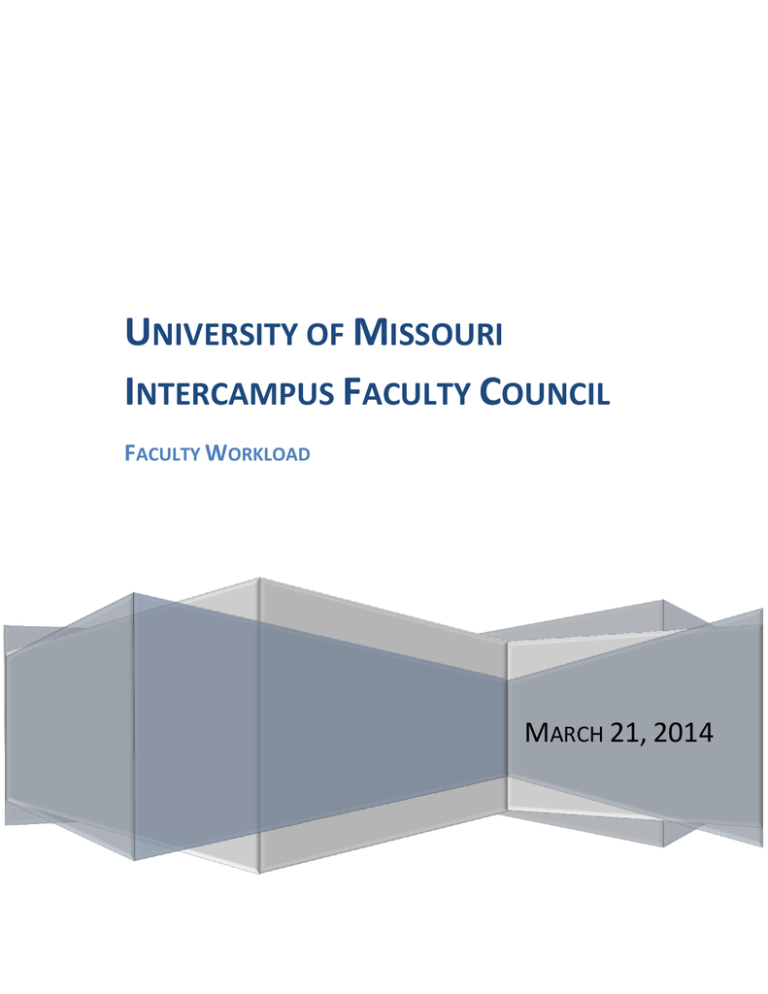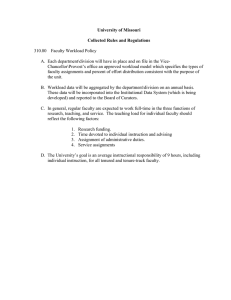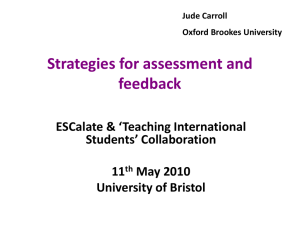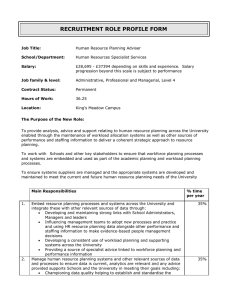U M I F
advertisement

UNIVERSITY OF MISSOURI INTERCAMPUS FACULTY COUNCIL FACULTY WORKLOAD MARCH 21, 2014 UNIVERSITY OF MISSOURI IFC STATEMENT ON FACULTY WORKLOAD INTRODUCTION AND BACKGROUND Due to increasing pressure on budgets, increasing student enrollment, and increasing public scrutiny, more attention has been focused on the workload of faculty in today’s public universities. After several discussions, the UM Intercampus Faculty Council (IFC) created a task force to examine the faculty workload policies. The committee’s charge was to determine how to create policies where all faculty members could flourish, the workload is more or less evenly distributed within departments and across units, there is a shared sense of responsibility for monitoring workload, and where faculty have the greatest degree of autonomy in carrying out their work. The task force was comprised of one senior faculty member from each of the UM campuses and was staffed by the Office of Executive Vice President for Academic Affairs. The committee members held discussions with IFC members about key issues, consulted various University of Missouri school and college workload policies, consulted relevant UM policy documents, and interviewed current UM department chairs on all four campuses. The committee also looked at a number of other workload policies from peer institutions to get a sense of potentially useful practices adopted elsewhere. After reviewing the information noted above – the committee drew the following initial conclusions: The existing UM Collected Rules and Regulations on faculty workload (310.080) appear to be fairly well written. The CR&R provide for variable workloads by academic unit and include approvals by the dean and provost to ensure they are meeting department and college expectations before adoption. A formal five-year review of the workload policy is required as part of the departmental five-year reviews. CR&R 310.080 recommends different assignments for faculty members based on the needs of the departments. It specifically states, “The Department Chair, in consultation with the individual faculty member, will determine a faculty member's assignments and distribution of effort in the areas of teaching, research, service and administration relative to the departmental workload standard. Assignments among faculty members will vary to meet the objectives of the department.” The committee members recognized that diverse academic units have variable needs and carry out their work differently. Thus, prescriptive policy statements that apply to all colleges and schools on each campus would not be suitable. 1|P a g e March 21, 2014 IMPLEMENTATION ISSUES Despite the flexible nature of the current CR&R on faculty workload, conditions exist where some faculty members take on a much greater load than others. Previous practices and cultural norms can at times trump concerns for equity, and department chairs report feeling handicapped in ensuring that all faculty members carry a fair share of the department’s responsibilities. In interviewing department chairs, task force members reported that: o A number of “deals” exist with faculty members that reduce their teaching load or create special arrangements. o Department chairs feel they are bound to the “deals” – although they may not have been involved in making them. At times deals are made at the dean or provost level. o Chairs and associate deans often report that they would like concrete guidelines they can draw upon instead of negotiating with each faculty member. They would also like alternative benefits they can offer for special assignments other than a “reduced teaching load” that is often used. o In many cases chairs are not well informed on the best practices and can be persuaded to accept arrangements with faculty members they later find are not in the best long-term interest of the department. o Some chairs report they find it easier to “pick up the extra slack” by personally teaching more or taking on other responsibilities when extra effort is needed, rather than push those who are not sharing the load. o Chairs often do not know how to address performance issues with faculty to ensure the department workload is implemented fairly across the unit without disrupting the departmental culture. o There is a general recognition that different faculty have different strengths in teaching, research and service. However, there is resistance to adjusting the standard workload where most faculty members have roughly equal assignments of teaching and research to address imbalances. o For any workload adjustments to be successful, chairs feel they need the support of their deans and provosts so that all departments in a college or school adopt similar approaches. 2|P a g e March 21, 2014 POLICY STATEMENTS The attached document articulates a number of issues and principles that can be used to create equitable workload assignments for academic departments. Embedded are the assumptions that: Finding a fair way to distribute work among the tenured/tenure track/non-tenure track faculty is critical in today’s climate. It is a campus-wide shared responsibility to implement workload policies that are flexible, make adjustments for individual faculty talents, vary based on the special talents of the faculty, and produce conditions where all faculty members feel they can be successful. Practices that foster “self-monitoring” and flexibility in allocating faculty workload assignments are preferred over prescriptive policies or restrictive rules written at the university system level. One strategy for promoting an equitable workload distribution is to make the details of the department members’ workload assignments transparent. A document listing workload assignments can be distributed each year explaining how faculty members meet their commitment to the department and college. Faculty members, such as endowed chairs, whose appointments include a reduced teaching assignment, are expected to meet higher research and scholarship standards to justify the reduced teaching load. The department chair should review these workload assignments annually. Any changes in current practices must include cooperation among department chairs, deans, and provosts. This includes monitoring campus and college workload policies, reviewing and monitoring instructional waivers, and reviewing the productivity of departments in the context of the campus and national norms for peer institutions. The IFC should work with the campus provosts to identify best practices and proper training for department chairs. For any workload policy to be effective it must be reviewed regularly, articulated clearly in writing, and administered fairly. Further, chairs must feel they are supported fully by deans and provosts as they implement agreed upon faculty workload policies. IFC should present their recommendations to the chancellors and general officers to create support and buy-in from the very top levels of the University. UM Collected Rules and Regulations on Faculty Workload - 310.080 http://www.umsystem.edu/ums/rules/collected_rules/faculty/ch310/310.080_regular_faculty_workload_policy UM Collected Rules and Regulations on Non-tenure Track Faculty – 310.035 http://www.umsystem.edu/ums/rules/collected_rules/faculty/ch310/310.035_non-tenure_track_faculty 3|P a g e March 21, 2014 FACULTY WORKLOAD: A RATIONALE The University of Missouri holds itself to a high standard of accountability. Like all universities, a significant portion of the University of Missouri budget is devoted to faculty costs. Hence, it is crucial that faculty costs be allocated efficiently and effectively to best support the teaching, research, and service missions of the University system. Currently, faculty workloads are allocated differently across departments, colleges, and campuses. If effectively designed, a workload allocation process can enhance faculty productivity by capitalizing upon the relative strengths of the individual faculty members. Further, a well-designed faculty workload policy can create rewards for faculty members that perform admirably in their respective areas of expertise. Such rewards might include favorable annual performance reviews, above-average salary increases, or special assignments. This document seeks to establish principles that departments can use to efficiently allocate workload across faculty members to the benefit of the collective faculty in the university1. The motivation for the document is twofold. First, it will provide academic officers and department heads with a template for allocating the unit’s workload to insure equity in distributing a department’s duties. Second, in the spirit of accountability, it will help to inform external stakeholders about the workload involved in the University’s units and how that workload is allocated among faculty members to achieve the most effective combination of activities. An academic department or college draws upon a number of different faculty resources to accomplish its goals. That includes tenured faculty, tenure-track faculty, non-tenure track faculty, and adjunct and visiting faculty. Non-tenure track faculty members take on a variety of roles in teaching, research and advising that are essential to the academic unit. The workload expectations for non-tenure track faculty are more focused than those for the tenure/tenure track faculty and detailed guidelines are provided in section 310.035 of the Collected Rules and Regulations. Section 310.035 also specifies that nontenure track faculty be given clear expectations and evaluated annually to provide guidance for their workload and role expectations (see CR&R 310.035 sections C, D, G, and I). Therefore, the focus of this document is on the workload for tenure and tenure track faculty. For any workload policy to be effective, the overarching principle is that department faculty members should focus on what they do best. Further, viewing productivity from a department-wide perspective is more useful than evaluating the productivity of 1 Many Universities have such a policy and process. The task force reviewed several such documents and found the working document at Drexel University to be especially well conceived. Thus, the Drexel University document was used as a template for developing this document and several sections draw heavily upon the document. 4|P a g e March 21, 2014 individual faculty members. The faculty workload in a department typically includes teaching, research/scholarship/creative activity, and service responsibilities. The teaching activity is the most quantifiable component. Department heads determine the courses that will be offered each semester and the number of sections of these courses. The teaching workload is then allocated to faculty members based on their predetermined credit hour teaching requirement. Adhering to the principle that faculty should focus on what they do best, the teaching assignment for active and successful researchers could be reduced so that these faculty members can maximize the research, publications, grants, or other scholarly activities as defined by the academic department. Those faculty members who are less prolific on the research dimension but are effective teachers then could cover a greater percentage of the teaching workload. Key to the success of the process is that faculty members who are asked to invest a greater amount of time in either the teaching or research missions are rewarded when they excel in that dimension. It follows that a well-designed and administered workload allocation process can result in a situation where all faculty members experience better performance evaluations. The prolific researcher will have more time to work on publications, grants, or other scholarly activities, and the prolific teacher would be handsomely rewarded for outstanding results in the classroom. It must be emphasized here that the awarding of tenure and promotions from Assistant Professor to Associate Professor and from Associate Professor to Professor requires excellence in teaching, scholarly activity, and service. Hence, Assistant Professors and Associate Professors seeking tenure and/or promotion will not be able to gain such promotion solely on only one of the dimensions of academic activity. 5|P a g e March 21, 2014 WORKLOAD PHILOSOPHY The overarching principle for assignment of faculty workloads is to assure that departments fulfill their responsibilities in teaching, research, and service. Working within a department’s allocated budget requires a variable workload program that allows faculty members to contribute by participating in activities that they do best – and at the same time accomplish the full mission of the academic department. Missions and instructional pedagogies differ across departments, thus the responsibility for determining specific faculty workloads under this principle rests with the department head subject to the approval of the Dean and the Provost. STEP 1 - DETERMINING UNIT RESPONSIBILITIES Each department should develop a normative model as a framework for workload assignments. This normative model will reflect the following from each academic dimension: (1) Teaching: the number and types of students to be served, maximum and minimum class sizes, and other pedagogical considerations unique to that department; (2) Research: goals for grant proposal production, publications, and other creative activities; (3) Service: the service obligations for faculty members in that department to the department, the school or college, the university, and the external community. Modifications should occur periodically in any or all of these dimensions as the department’s needs and goals change. STEP 2 - ALLOCATION OF WORKLOAD RESPONSIBILITIES TO FULL-TIME FACULTY The overall workload responsibilities within each department identified in step one are allocated in a manner that maximizes the overall productivity of the department while allowing each individual faculty member to contribute in alignment with his/her professional strengths. While no set formula for assignments of workload responsibilities can be set forth here because of the variances among departments and colleges, the following concepts are assumed: (1) Research-active faculty in departments will have a normal teaching assignment for that unit with the remainder of their assignments in research and service. 2 2 The “normal” teaching load in terms of courses might be reduced because of assignment to especially large classes or time intensive course preparations. 6|P a g e March 21, 2014 (2) Prolific researchers may have their teaching and/or service workload reduced so that they may further the department’s research mission. (3) When a prolific researcher has a reduced teaching responsibility and/or service responsibility - that responsibility will be assigned to another faculty member in the department that is prolific on the teaching and/or service dimension. (4) It is likely that the tenured/tenure track faculty members will not be able to fulfill the entire teaching responsibility of a department. In these cases, the remaining obligations will be allocated to non-tenure track faculty, adjunct faculty and to teaching assistants consistent with all applicable policies at that department, college, and campus. STEP 3 - FACULTY PERFORMANCE REVIEWS Each year, performance review data serve as the basis for merit-based salary increases and for workload assignments for the following academic year. These performance reviews should be based on the percentage weight assigned to each academic activity dimension described previously. In other words, if a faculty member has agreed to emphasize his/her teaching strengths via a relatively heavier teaching load, that faculty member should qualify for merit-based pay rewards based commensurately on his/her performance on that dimension. Similarly, the faculty member’s performance in the current year on each dimension will inform the determination of that faculty member’s workload allocation across the three academic dimensions for the upcoming year. If appropriate, a department institute an appeal processes for faculty members who want to review their workload assignment for the upcoming academic year. STEP 4 - ASSESSMENT OF THE WORKLOAD POLICY Academic departments in conjunction with college and campus instructional committees and campus academic officers should continually assess the effectiveness of the workload policy in facilitating fulfillment of the workload obligations of that department in the most efficient and effective manner. One strategy would be to assess the overall productivity of each faculty member on a three-year cycle based on the different assignments they have agreed to undertake. This avoids hasty judgments about success in new roles and allows time for faculty members to develop expertise when new skills are being developed. It also allows faculty members to amend their percentage distribution of activities, and re-align their workload as their career focus changes. 7|P a g e March 21, 2014 FIT AND APPROPRIATE MATCH Ensuring that faculty workload assignments are an appropriate match with their talents and that there is an appropriate balance of duties are important considerations in creating an effective workload policy. This requires linking the work that faculty members are assigned to their annual merit evaluations and tailoring their evaluations instead of using a “one-size fits all” approach. Faculty members and departments should also acknowledge that there are specific requirements for tenure or promotion and be mindful of those in making workload assignments. Future workload assignments may be more flexible - based on the needs of the department and college and the faculty members’ talents. The total workload will likely require duties at the university-wide level and at the school, college, and department levels. These units have different goals within the university-wide mission and strategic plan. Thus, faculty work assignments will vary among and even within the colleges and schools based on the college and department mission and goals. FAIRNESS The fairness of assignments refers to the manner in which the workload is allocated to faculty so that they are working in areas where they have strength and professional competence and the load is equivalent even if varying from the standard teaching/research/service allocations. Equally important, the work of the department should be distributed among the faculty members based on the specific needs of the department and not just based on what the faculty member prefers to do. Transparency in reporting each faculty member’s contributions to the total department workload will provide an overall picture and be used to guide the ‘appropriate’ activities of the department based on the overall workload. THE FOLLOWING FUNCTIONS ARE ILLUSTRATIONS TO BE CONSIDERED FOR THE PURPOSE OF DETERMINING WORKLOAD. INSTRUCTION Faculty who are assigned instruction as a component of their workload must demonstrate teaching excellence based on their depth of their expertise and scholarship. The following are examples of different instructional assignments: regular teaching assignments, development of innovative courses, leadership in designing new curriculum, leadership for multi-section courses, or carrying an extensive load of independent study courses, and theses or dissertations. 8|P a g e March 21, 2014 RESEARCH OR OTHER CREATIVE SCHOLARLY ACTIVITIES Faculty members with assignments that include research, scholarship, and other creative activities should demonstrate excellence in fulfilling that obligation. The following items are examples of research or other creative scholarly activities: publication of books, articles, monographs, and other scholarly works, competitive grants and contracts, patents, distinguished consulting, juried works and exhibitions, notable creative works, plenary talks at national and international conferences, and other invited presentations (e.g., colloquium talks). UNIVERSITY, PROFESSIONAL, AND PUBLIC SERVICE University service includes activities related to participation in shared governance and other duties that contribute to the success of the University in accomplishing its mission. This includes activities such as involvement in campus governance, leadership roles in campus committees, special consultation to academic or administrative units on campus, providing teaching or conducting workshops for members of the campus community, etc. Professional, academic or public service may involve such items as service to professional societies, serving as an editor for professional journals, providing consultation in one’s area of expertise to governmental agencies or commissions, developing strategies to attack persistent problems locally or nationally, field studies, consultation with local or state agencies, working with local high school teachers and students, etc. This type of service is applying one’s special knowledge, research skills, teaching or technical expertise in areas to provide a service to the university, the local or regional community, or the nation. 9|P a g e March 21, 2014






![Guidelines for Academic Workload Allocation[1]](http://s3.studylib.net/store/data/007357775_1-c08378375a61bf04d5de327b7ce434b5-300x300.png)
